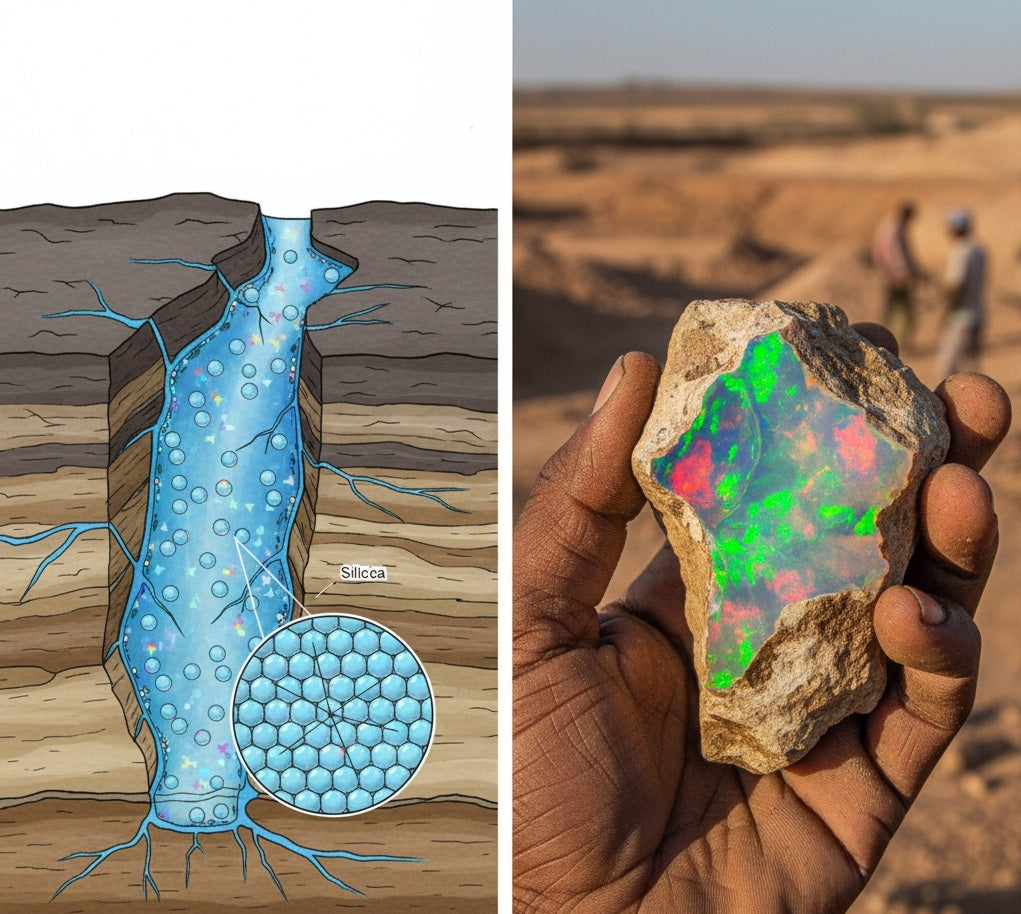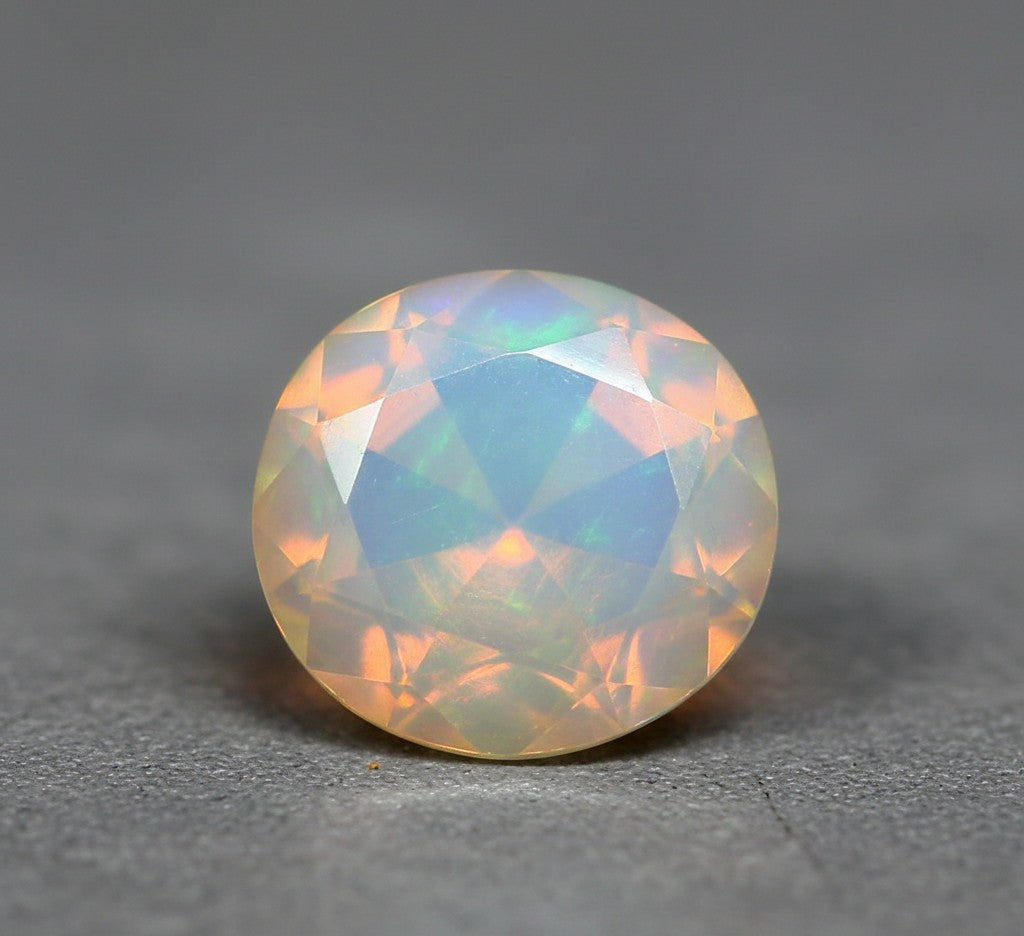Article: The Gem of the Gods: How Nature Crafts an Opal

The Gem of the Gods: How Nature Crafts an Opal
Every opal is a miniature masterpiece, a celestial landscape of flashing color captured in stone. This otherworldly beauty has led to a rich history of folklore, with Romans believing it a symbol of hope and ancient Greeks thinking it held the power of prophecy. But the true story of an opal's creation is a tale of geology, water, and time—a recipe of cosmic coincidence that results in one of the world's most captivating gems.
The Essential Ingredient: Silica and Water
At its core, opal is a form of hydrated amorphous silica (SiO2⋅nH2O). That might sound complex, but let's break it down. Its primary ingredient is silica, the same compound that makes up quartz and sand. The magic happens when this silica mixes with water.
Imagine seasonal rains drenching a dry, silica-rich landscape. As the water percolates down through the earth, it dissolves the silica, creating a unique solution. Over vast periods, this silica-rich water seeps into cracks, fissures, and cavities in the host rock.
A Cosmic Game of Marbles: The Birth of Play-of-Color
As the water slowly evaporates over thousands, even millions, of years, it leaves behind tiny, microscopic spheres of silica. These spheres settle and stack upon each other in a remarkably orderly, three-dimensional grid—like marbles being carefully arranged in a box.
It is this precise, uniform structure that gives precious opal its signature play-of-color. When light waves enter the stone, they diffract, or bend, as they pass through the tiny gaps between these silica spheres. This diffraction splits the white light into its spectral colors, the same phenomenon you see in a rainbow or a prism. The size of the spheres determines the color you see: smaller spheres produce blues and violets, while larger spheres create the rarer and more valuable oranges and reds.
In "common opal" or "potch," the silica spheres are jumbled and disorganized, so light cannot diffract, and no play-of-color is produced.
Two Paths to Creation: Volcanic vs. Sedimentary
Not all opals are born the same way. The geological environment plays a huge role, leading to two main types of formation.
1. Sedimentary Opals (The Australian Story): The vast majority of the world's opals, particularly from the iconic fields of Australia, are sedimentary. They formed in the basin of a great ancient inland sea. As the sea receded, it created perfect, alkaline conditions for the silica-rich solution to fill voids left by decomposed fossils, wood, and cracks in the sandstone and claystone (sedimentary rocks). This is why you can find incredible opalized fossils, from shells to dinosaur bones!
2. Volcanic Opals (The Ethiopian Fire): Ethiopian opals, our specialty, are born from fire. They form in the cavities and layers of volcanic rock, primarily rhyolite. The silica-rich water is a product of volcanic activity. This different geological origin gives Ethiopian opals their unique characteristics, such as their hydrophane nature (the ability to absorb water) and often spectacular, vivid patterns.
A Treasure Map of the World: Where Are Opals Found?
While opals are coveted globally, precious opal is remarkably rare, found in only a handful of locations.
-
Australia: The undisputed king of the opal world, Australia produces an estimated 95% of the global supply. Legendary mining towns like Coober Pedy, Lightning Ridge (home of the famous black opal), and Andamooka in the arid outback are synonymous with opal.
-
Ethiopia: The most significant discovery of the modern era! The Welo (Wollo) Province, since 2008, has become a major source of high-quality precious opal. These volcanic opals have taken the gem world by storm with their brilliant fire and affordability. Earlier discoveries were also made in the Shewa Province.
-
Mexico: Famous for its fiery red and orange "fire opals" and beautiful "water opals," which are often faceted rather than cut into cabochons. These are also volcanic in origin.
-
Brazil: For decades, Brazil has been a steady producer of beautiful white precious opals, known for their durability and stability.
-
Other Notable Locations: Pockets of precious opal have also been found in places like Nevada and Oregon in the USA (known for stunning "fire" and "contaluz" opals), Indonesia, Peru(home to beautiful pink and blue common opal), and Slovakia.
The journey of an opal from a simple silica solution to a dazzling gemstone is a testament to the slow, patient artistry of nature. Each flash of color is a snapshot of an ancient, water-logged world, a story of geology and time that you can hold in your hand. When you own an opal, you own a small piece of Earth's incredible history.


Leave a comment
This site is protected by hCaptcha and the hCaptcha Privacy Policy and Terms of Service apply.